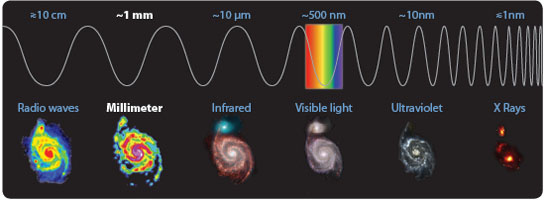Why radioastronomy?
Radioastronomy plays an essential role in modern-day astrophysics and is a key complement to optical astronomy. Compared to optical astronomy, which is sensitive to the hot universe (stars are generally a few thousand degrees Celsius), radiotelescopes that operate in the millimeter wavebands, such as NOEMA, probe the cold universe (around -250 degrees Celsius).
Millimeter radioastronomy is therefore able to:
- detect star formations hidden behind clouds of dust making them invisible to optical telescopes
- identify interstellar molecules and study cosmic dust, key elements of star and galaxy formation
- observe galaxies and quasars at the outer limits of the univers
- help us understand the evolution of the universe

The illustration above shows where NOEMA will operate in relation to other well known wavelengths, from radio waves to x-rays. The M51 galaxy is represented as it is observed at each frequency. By combining data from across the spectrum astronomers are constantly increasing their knowledge of distant cosmic objects.
For more information about radioastronomy and detecting signals at milimmeter wavelengths, click here.

